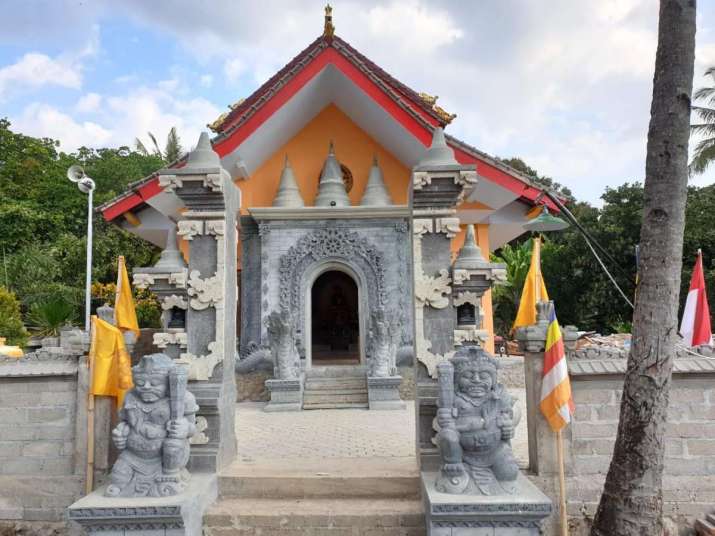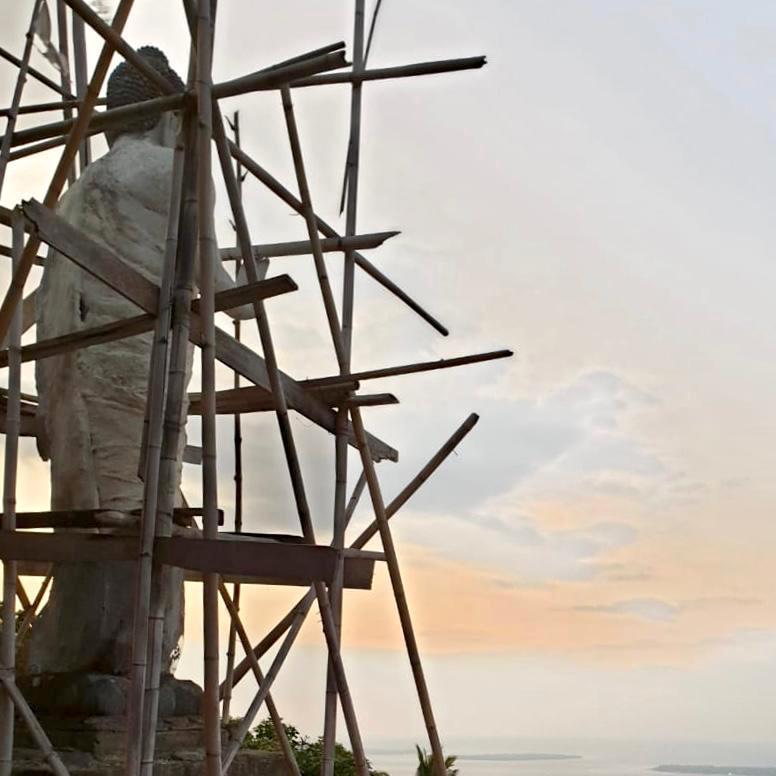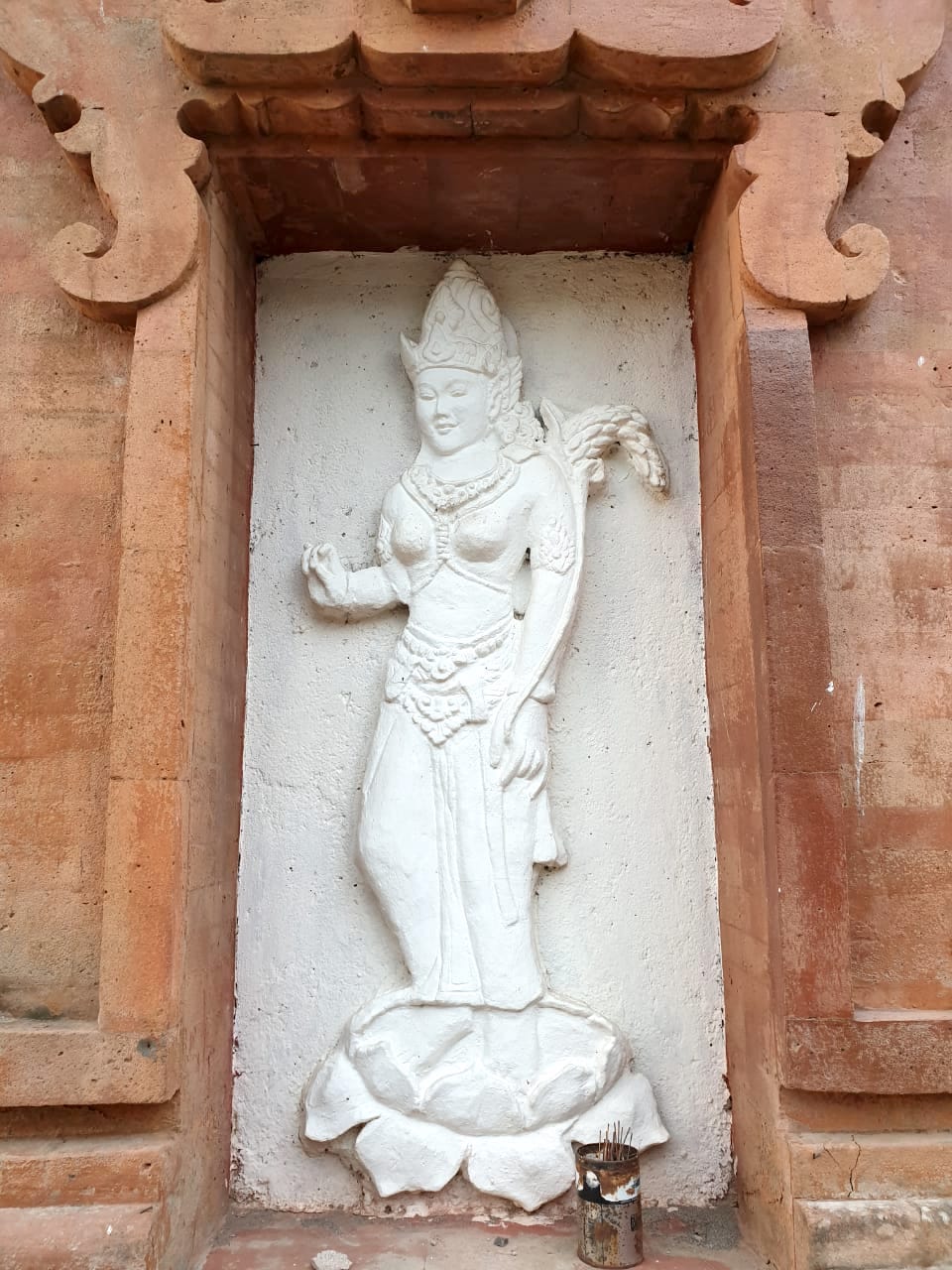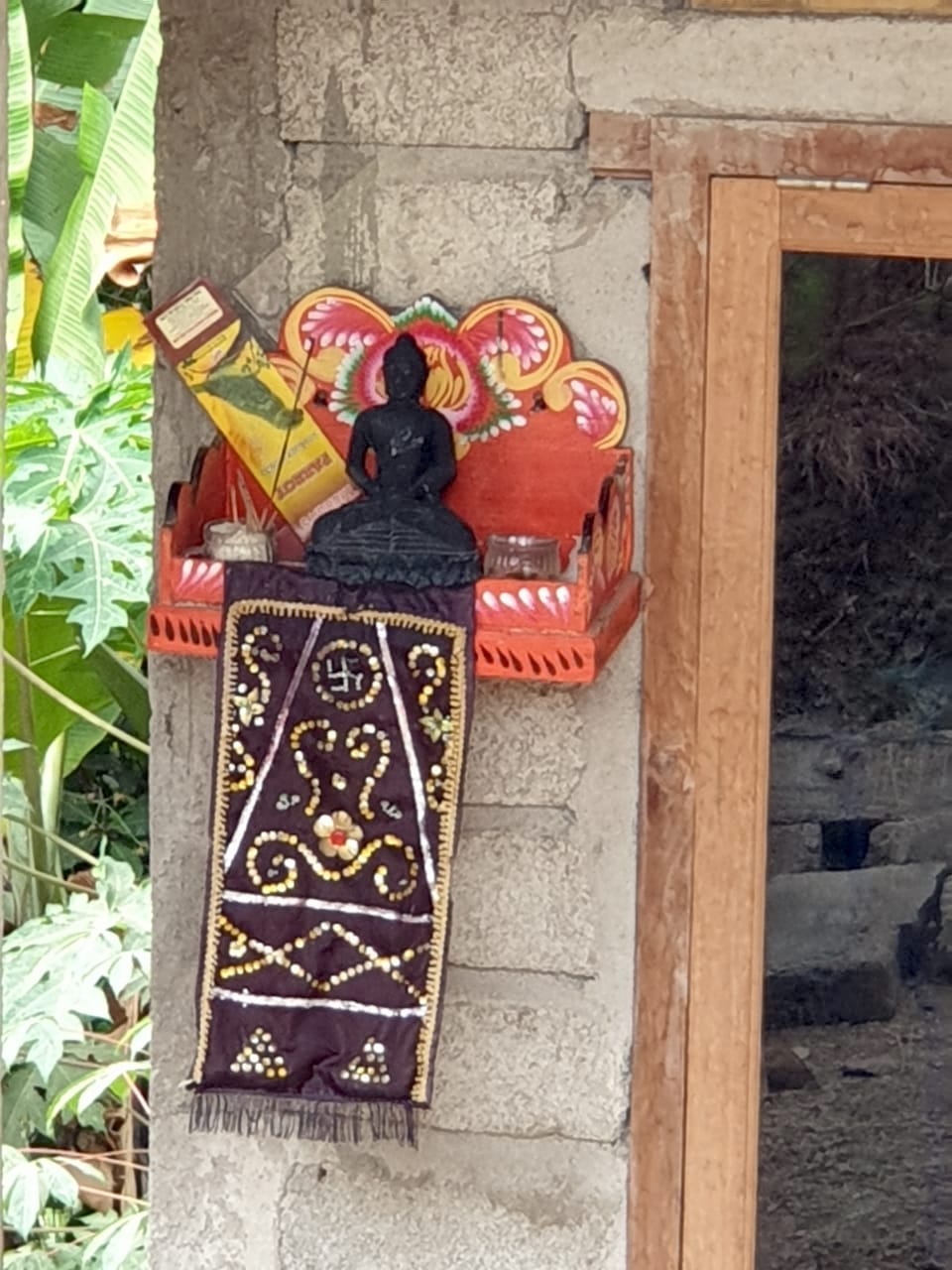FEATURES|THEMES|Travel and Pilgrimage
Rediscovering an Ancient Heritage in Indonesia
 A typical Lombok Buddhist temple. Note the Balinese-style split gates and Antaboga flanking the temple entrance. Note also the Borobudur stupa reproductions atop the split gates and the speakers on the left of the temple. Image courtesy of Dr. Metta Agustina
A typical Lombok Buddhist temple. Note the Balinese-style split gates and Antaboga flanking the temple entrance. Note also the Borobudur stupa reproductions atop the split gates and the speakers on the left of the temple. Image courtesy of Dr. Metta AgustinaIndonesia is not a country known for Buddhism; Buddhists represent a tiny minority of the country’s population at 0.7 per cent, dwarfed by the 87.5 per cent Muslim majority. While the archipelago that now constitutes the Republic of Indonesia was once ruled by the predominantly Buddhist Srivijaya (650–1377) and Majapahit (1293–1527) empires, it is generally thought that all that is left from those times are a number of scattered semi-ruined temples and stupas. The most famous of these by far is the magnificent Borobudur outside Yogyakarta in Central Java. While Buddhism is one of Indonesia’s six state-recognized religions (along with Catholicism, Confucianism, Hinduism, Islam, and Protestantism), Buddhism is perceived in Indonesia as primarily a religion of the ethnic-Chinese minority. What is little known, both in Indonesia and abroad, is that an indigenous Buddhist community tracing its origins back to the Srivijaya empire has survived on the island of Lombok until present day.
Lombok is located just east of the popular tourist destination Bali. The population is predominantly of the Sasak ethnic group and primarily practices Islam, though a sizable Balinese Hindu community also exists, particularly on the western part of the island. Unbeknown to even most Lombok locals, the island is also home to an estimated 10,000–20,000 Buddhists.* This Buddhist community is concentrated primarily in the mountains of northern Lombok, having isolated themselves there to avoid pressure to convert following the gradual Islamization of Indonesia from the 12th century onward. Although the community is primarily ethnically Sasak, many trace their heritage to Java, their ancestors having fled Java to avoid conversion to Islam. While indigenous Indonesian Buddhists are not unheard of in Indonesia, especially on Java, these are the result of a minor wave of conversions in the 1960s. However, the Buddhists of Lombok, as they will proudly tell anyone who asks, have been continually Buddhist for more than a millennium.
The denominational orientation of the Lombok Buddhists is a complex issue. Historically, the Srivijaya and Majapahit empires practiced primarily Mantrayana Buddhism, often syncretized with the earlier religion Shaivite Hinduism and even older animism. However, following Islamization, the isolated Lombok community was left without a monastic institution, access to scriptures, or even formal temples. As a consequence, their faith developed into a kind of doctrinally thin folk Buddhism. This changed only relatively recently during Indonesia’s “Buddhist revival” of the 1960s.
This revival was almost entirely the result of the efforts of one Mahabhiksu Ashin Jinarakkhita. Mahabhiksu Ashin was an Indonesian of Chinese descent whose vision of a (re-)indigenized Buddhism he termed “Buddhayana.” This entailed all Indonesian Buddhists—whether Mahayana, Theravada or Vajrayana—being united under a single organizational structure. The above-mentioned conversions of indigenous Indonesians to Buddhism were the fruit of his tireless work. One particular such convert was a man named Romo Komang Gede. Born in 1926 in Lombok’s capital Mataram to Balinese Hindus, Gede encountered Mahabhiksu Ashin and the Buddhadharma in the late 1960s when he was an officer in the riot police, then a branch of the Indonesian military. From this privileged position, Indonesia at the time being under a military-backed dictatorship, he worked tirelessly for the benefit of the isolated Buddhists of northern Lombok. He sought to provide them with the infrastructure of religion that they had lost over the previous millennia (scripture, monastic ordination, and formal temples).

This statue of the Buddha is all that was left standing after the 2018 Lombok
earthquake, the surrounding village and temple having been flattened. The villagers
see this as a miracle and have erected bamboo scaffolding to stabilize the Buddha.
Reconstruction of the temple is ongoing. The islands in the background are the popular
tourist destinations of Gili Air and Gili Meno. Image courtesy of Dr. Metta Agustina
Despite their ancestors’ practice of Vajrayana, Mahabhiksu Ashin feared that seeking to return the folk Buddhists of Lombok to orthodoxy, through introducing Tibetan-style Vajrayana or Chinese-style Mahayana, would provoke state reprisal. This has to be understood in the context of the assimilationist policies directed at the Chinese minority at that time. Instead, Mahabhiksu Ashin and Gede felt that Theravada would be more appropriate to the socio-cultural conditions of modern-day Lombok. As a consequence, the indigenous Buddhists of Lombok today are all Theravada Buddhists, and their spiritual needs are provided for by a sangha of 30 monastics (including Gede’s own daughter, Bhikkuni Nyana Pundarika).
Despite this, the indigenous Buddhism of Lombok is highly acculturated (active pursuit of acculturation being a conscious policy of Mahabhisku Ashin) and bears many unique features that may well be confusing for outsiders. Two sources of this acculturating influence can be identified: Indonesia’s Hindu-Buddhist past and its Abrahamic present.
Lombok-style Theravada Buddhism has assimilated the pre-existing practice of ancestor worship, the ceremonies and ritual clothing of which may appear very familiar to those acquainted with Balinese Hinduism, as will the home altars and architectural design of Lombok Buddhist temples. Rather than imitating the architecture of Southeast Asian Theravada temples, those in Lombok seek to emulate the architecture of famous Srivijaya- and Majapahit-era temples, resulting in ones that look very similar to Indonesian Hindu structures, save for the use of Buddhist iconography. Most of the latter are universally recognized Buddhist icons, such as the image of Shakyamuni Buddha, the Dhammachakra, and the pillar of Ashoka.
One symbol, however, is uniquely Indonesian and it is that of the distinctive stupas of Borobudur. Small-scale recreations of the stupa are ubiquitous in the Buddhist villages of Lombok—in temples, on shrines, tombstones, altars, school gates, and even painted on kitchen cupboards. Despite this, almost none of Lombok’s Buddhists are able to afford the cost of travel to witness Borobudur’s glory with their own eyes. Lombok’s largest temple, Wihara Jaya Wijaya, features a stupa bearing engravings of figures unique to Lombok Buddhism, such as King Panangkaran Syailendra, the first Buddhist monarch of the Srivijaya empire, and Dewi Sri, the Javanese goddess of rice. Reverence for Dewi Sri still exists in Java despite Islamization, but is not normally encountered in Lombok. Her worship was presumably introduced by the aforementioned Javanese Buddhists who came to Lombok almost a millennium ago.

Dewi Sri, the Javanese goddess of rice.
Image courtesy of Dr. Metta Agustina
Perhaps more surprising for outsiders are the influences drawn from Indonesia’s Abrahamic majority. Temples in Lombok practice congregationalism (with the exact day of congregation varying from village to village). One temple I visited bore a notice on its wall stating that weekly attendance on Sunday evenings is “compulsory” for all Buddhists in the village. Even more striking, temples are equipped with speaker systems for nightly broadcasts of the chanting of Pali suttas throughout Buddhist villages, in imitation of mosques broadcasting the Islamic call to prayer.
Also intriguing is Lombok Theravada Buddhism’s formal acceptance of the concept of “Sang Hyang Adi Buddha.” In order to receive recognition from the state, all religions in Indonesia must satisfy certain criteria—one of which being what may be rendered in English as belief in “a sole, supreme divinity” (Ketuhanan Yang Maha Esa). Strictly speaking abstract, impersonal conceptions of the Absolute, such as the Confucian Tian, Hindu Brahma, or Daoist Dao, satisfy this criteria. However, at the time of the Buddhist revival, Chinese Indonesians were under intense pressure to assimilate. As a consequence, Mahabhiksu Ashin sought a concept of “supreme divinity” in the Dharma that would be most readily recognizable and acceptable to predominantly Muslim authorities. Ultimately the venerable master offered the idea of “Sang Hyang Adi Buddha,” an Indonesian name for the Vajrayana concept of a “primordial Buddha.” Buddhayana literature also identifies Sang Hyang Adi Buddha with the Dharmakaya and Vairocana Buddha of the Avatamsaka Sutra.** While this is unproblematic for the Mahayana and Vajrayana branches of Buddhayana, it results in the Theravada people of Lombok somewhat awkwardly recognizing, at least formally, the existence of a “primordial Buddha” and opening their Dhamma assemblies with “Namo Sang Hyang Adi Buddhayya.”
Lombok is considerably poorer than the central Indonesian islands of Java, Bali, and Madura. However, the Buddhists of Lombok are poor even by the standards of Lombok. This is a result of their de facto exile to the Lombok highlands. Living in the mountains restricts them to harvesting primarily cocoa, bananas and coconuts as their land cannot support more profitable crops like rice, as is harvested in the lowlands. Most of the community is very hesitant to move to the more developed lowlands for fear of religious discrimination and pressure to convert to Islam. This not only limits them to low-income crops, but restricts their access to healthcare and education. It is heartening that, despite the deep-running and ongoing tensions between native and Chinese Indonesians, almost all of the funding for Lombok’s temples originates from Java’s wealthy ethnically Chinese and predominantly Mahayana Buddhist community.
That said, some Chinese Indonesian Buddhists are critical that funding from their community has been more forthcoming for the construction of temples in Lombok than for the material betterment of Lombok’s Buddhists, particularly after the 2018 Lombok earthquake. To rectify this, some in the Chinese Buddhist community have initiated the very earliest steps in seeking to establish a trade school in northern Lombok. Such a school could potentially open the door to upward social mobility for the poor and isolated Buddhists of Lombok. One hopes that the cross-ethnic and non-sectarian interactions between the indigenous Buddhists of Lombok and the Chinese Buddhists of Java that began with Mahabhiksu Ashin continue into the future for the material and spiritual benefit of all.

A Balinese style home shrine with a statue of the Buddha.
Image courtesy of Dr. Metta Agustina
* Reliable demographic data, particularly pertaining to religious minorities, can be difficult to find in Indonesia, and the issue can be rather sensitive. Official statistics from a 2016 report by the Nusa Tenggara Barat government states there are 10, 275 Buddhists in Lombok (Provinsi Nusa Tenggara Barat Dalam Angka 2016), while monastics I have spoken to estimate that there are 15, 000 Buddhists in northern Lombok alone.
**Adi Buddha dalam Agama Buddha Indonesia, Hudaya Kandahjaya, 1989
Related features from Buddhistdoor Global
Sky Lanterns and Walubi: My Waisak Day at Borobudur in 2018, Part 1
The Resistance: Indonesian Women Moving Against Religious Intolerance
Reviving the Bhikkhuni Sangha in Indonesia: an Interview with Ayya Santini
Related news from Buddhistdoor Global
Indonesia Bans Myanmar Protests at Borobudur Buddhist Temple
Indonesia Aims to Boost Spiritual Tourism at Borobudur Buddhist Temple
Muslim Students Help to Rebuild Buddhist Temples in Indonesia
David Bowie Requested Ashes to be Scattered in Buddhist Ceremony in Bali
Borobudur to Become an International Destination for Buddhist Pilgrims














